On and Off the Hill
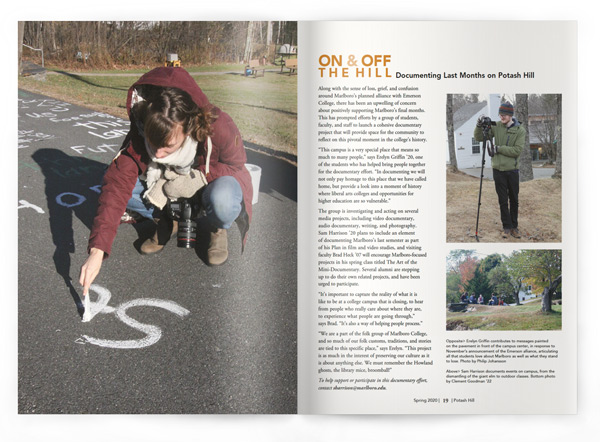
Documenting Last Months on Potash Hill
Along with the sense of loss, grief, and confusion around Marlboro’s planned alliance with Emerson College, there has been an upwelling of concern about positively supporting Marlboro’s final months. This has prompted efforts by a group of students, faculty, and staff to launch a cohesive documentary project that will provide space for the community to reflect on this pivotal moment in the college’s history.
“This campus is a very special place that means so much to many people,” says Erelyn Griffin ’20, one of the students who has helped bring people together for the documentary effort. “In documenting we will not only pay homage to this place that we have called home, but provide a look into a moment of history where liberal arts colleges and opportunities for higher education are so vulnerable.”
The group is investigating and acting on several media projects, including video documentary, audio documentary, writing, and photography. Sam Harrison ’20 plans to include an element of documenting Marlboro’s last semester as part of his Plan in film and video studies, and visiting faculty Brad Heck ’07 will encourage Marlboro-focused projects in his spring class titled The Art of the Mini-Documentary. Several alumni are stepping up to do their own related projects, and have been urged to participate.
“It’s important to capture the reality of what it is like to be at a college campus that is closing, to hear from people who really care about where they are, to experience what people are going through,” says Brad. “It’s also a way of helping people process.”
“We are a part of the folk group of Marlboro College, and so much of our folk customs, traditions, and stories are tied to this specific place,” says Erelyn. “This project is as much in the interest of preserving our culture as it is about anything else. We must remember the Howland ghosts, the library mice, broomball!”
To help support or participate in this documentary effort, contact sharrison@marlboro.edu.
Campus Visits Promote Understanding
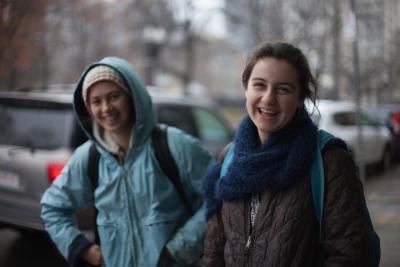 The November announcement of the alliance between Marlboro College and Emerson College has been followed by a series of visits by members of both campuses, helping to build relationships and a common understanding of the future of Marlboro. The first of these visits was on November 20, when five members of the Emerson leadership visited Marlboro to answer questions and get a feel for the mood of the campus around the proposed alliance.
The November announcement of the alliance between Marlboro College and Emerson College has been followed by a series of visits by members of both campuses, helping to build relationships and a common understanding of the future of Marlboro. The first of these visits was on November 20, when five members of the Emerson leadership visited Marlboro to answer questions and get a feel for the mood of the campus around the proposed alliance.
“Our students and you share some commonalities,” said Emerson President Lee Pelton, who addressed Town Meeting on behalf of the visitors. “They see in Emerson a place of magic, a place of creativity, a place where there are independent-minded people, and where students have agency. And my sense is that many of those characteristics are common to those of you who decided to come to Marlboro.”
Pelton expressed optimism that Marlboro students and faculty and their counterparts at Emerson could work together to create an academic program of excellence. In addition to attending Town Meeting, the visitors lunched with faculty, met with faculty committees, listened to senior Plan presentations, and concluded their visit by having tea with students to respond more specifically to their concerns.
That visit was followed with a trip by 40 students and faculty to Emerson’s Boston campus on November 24, to get a tour of campus facilities, meet some students, talk about curriculum, and see an ArtsEmerson production of An Iliad. This visit was facilitated by Marlboro life trustee and former staff and faculty member Ted Wendell, who has also been a longtime supporter of ArtsEmerson.
“This was a way of introducing to Marlboro some of the richness that Emerson has to offer and getting them on the actual campus,” Ted said in an interview with the Emerson student publication the Berkeley Beacon. “I think getting the two parties to get to know each other and start to understand the strengths and values of each other is the best way to have it be smooth and fruitful for both sides—to have this new relationship prosper.”
Building on these experiences, a group of Marlboro students invited students from Emerson College to enjoy part of Thanksgiving break on Potash Hill, and 10 students from Emerson came to Marlboro for two nights. They shared meals together, including Thanksgiving dinner, and explored and connected with the particular sense of place that is uniquely Marlboro.
Marlboro senior Adam Weinberg, who orchestrated the Thanksgiving visit, felt the brief trip brought some profound moments for shared reflection—from face to face engagement, to appreciation for Marlboro’s spirit of trust and open access to facilities, to theoretical questions of “Why liberal arts?” and “What does it mean to explore across fundamental questions?” The morning before returning to Boston, the students expressed great thanks for Marlboro’s sincere hospitality along with a heartfelt promise to hang out again, soon.
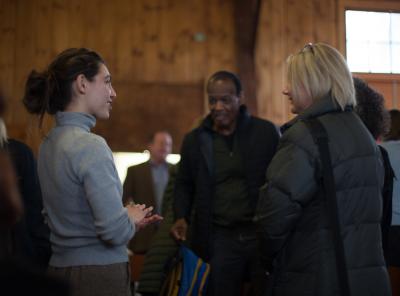 Emerson staff in admissions, student success, and other departments visited campus in January to meet with Marlboro students and discuss their potential transition to Emerson’s community. Students were also welcomed to Emerson for a group visit on February 14, and ongoing individual visits throughout the spring 2020 term, to experience the college’s community, offerings, and classes.
Emerson staff in admissions, student success, and other departments visited campus in January to meet with Marlboro students and discuss their potential transition to Emerson’s community. Students were also welcomed to Emerson for a group visit on February 14, and ongoing individual visits throughout the spring 2020 term, to experience the college’s community, offerings, and classes.
There have been several exchanges of faculty visits as well, starting with visits to Emerson in the week of December 2 and return visits to Marlboro in the week of December 16. These have been valuable opportunities to learn more about where Marlboro faculty will fit into Emerson’s programs and departments, how the curriculum for the new Marlboro Institute is expanding to embrace them, and what resources and facilities are available to them.
“As we enthusiastically shared ideas and goals, I wished our community could see the good will and compassion with which we were greeted by students, staff, and faculty,” said theater and gender studies professor Brenda Foley, following her first visit to Emerson. “Working with faculty peers at Emerson on our alliance convinced me that the coming together is far more than a pact ‘in name only.’ It promises an opportunity to carry with us intrinsic elements of a Marlboro education we hold dear, leave behind aspects that are no longer productive, engage with a more diverse cohort, and conceive of expansive and exciting new projects.”
The visits will continue to fill in the gaps between two cultures, between two campuses, and between idealistic hopes and concrete plans. “I feel fortunate to be making the journey with so many of my Marlboro faculty colleagues and students and look forward to the transformation to come,” added Brenda.
Working Groups Get Down to Details
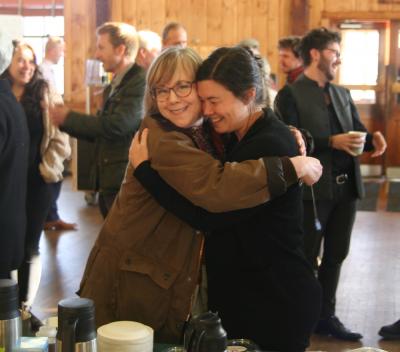 Following quickly on the announcement of Marlboro’s alliance with Emerson College, working groups were formed to consider options and advocate solutions for key constituencies and interests, including students, faculty, staff, and the future of the campus. Most working groups took advantage of committees already engaged in advocating for these groups, and included trustees, faculty, staff, students, and, in the case of the campus working group, alumni. The student working group has the goal of charting the smoothest possible transition for students to Emerson or another institution of their choice, and of aligning student data with Emerson’s systems.
Following quickly on the announcement of Marlboro’s alliance with Emerson College, working groups were formed to consider options and advocate solutions for key constituencies and interests, including students, faculty, staff, and the future of the campus. Most working groups took advantage of committees already engaged in advocating for these groups, and included trustees, faculty, staff, students, and, in the case of the campus working group, alumni. The student working group has the goal of charting the smoothest possible transition for students to Emerson or another institution of their choice, and of aligning student data with Emerson’s systems.
The group is made up of the Dean’s Advisory Committee as well as Dean of Students Patrick Connelly, Dean of Admissions Fumio Sugihara, trustee and parent Susan Wefald, Director of Financial Aid Kristin Hielmenski, Registrar Cathy Fuller, IT Director Michael Riley ’09, and religion professor Amer Latif.
“We arranged four listening sessions with students in November and December, to allow students to voice their opinion regarding the proposed alliance and answer any questions,” said Patrick, who held the sessions. “They were well received, and helped lessen student anxiety about the alliance.” Student Life has increased social programming and events on campus in order to engage students in a healthy and productive way, and added additional counselors to the Total Health Center to support students feeling challenged by their next steps.
The working group has helped orchestrate visits between Marlboro students and Emerson staff and students (see page 20), and provided information about housing and financial aid to students and families transitioning to Emerson. In January the college announced that it would cover the difference in housing costs for students going on to Emerson, removing a huge barrier for many students. The working group has also supported the negotiation of transfer options with four other institutions—College of the Atlantic, Bennington College, Castleton University, and Saint Michael’s College— waiving application fees and other transfer requirements and offering comparable financial aid.
“We understand students have various preferences and needs in meeting their academic goals, and that for some students transferring to an institution other than Emerson may be their best path forward,” said Fumio. “Admissions will support any student interested in transferring to an institution other than the Marlboro Institute at Emerson.” The college has agreed to pay application fees for students transferring to other, non-partnered colleges.
The working group on faculty includes members of the Committee on Faculty, Curriculum Committee, and faculty and students from the Strategic Options Task Force, as well as Provost and Dean of Faculty Richard Glejzer and trustee Donna Heiland. This group has the task of clarifying curricular requirements for students and developing an advising program for transition to Emerson. Working with their counterparts at Emerson, they have been building a four-year program that incorporates significant aspects of Marlboro’s curriculum, including an emphasis on writing and individualized study that will draw upon Marlboro’s tutorial model.
“It has been heartening to see how Emerson faculty eagerly welcome the expertise of Marlboro faculty in designing and implementing a new four-year degree program that includes individualized study,” says Richard. “Marlboro faculty have been driving the conversation on the curriculum, while learning from their counterparts about Emerson students and the spaces they will be working in.” The working group presented a proposal to Emerson in February, which then needs to work its way through Emerson’s governance structure for final approval.
The working group on staff has the task of stewarding the staff through the transition, and supporting staff well-being during what is admittedly a difficult time. This group is made up of the Committee on Staff and the Benefits Committee, and also includes COO Becky Catarelli and trustee and alumni parent Kirsten Malone.
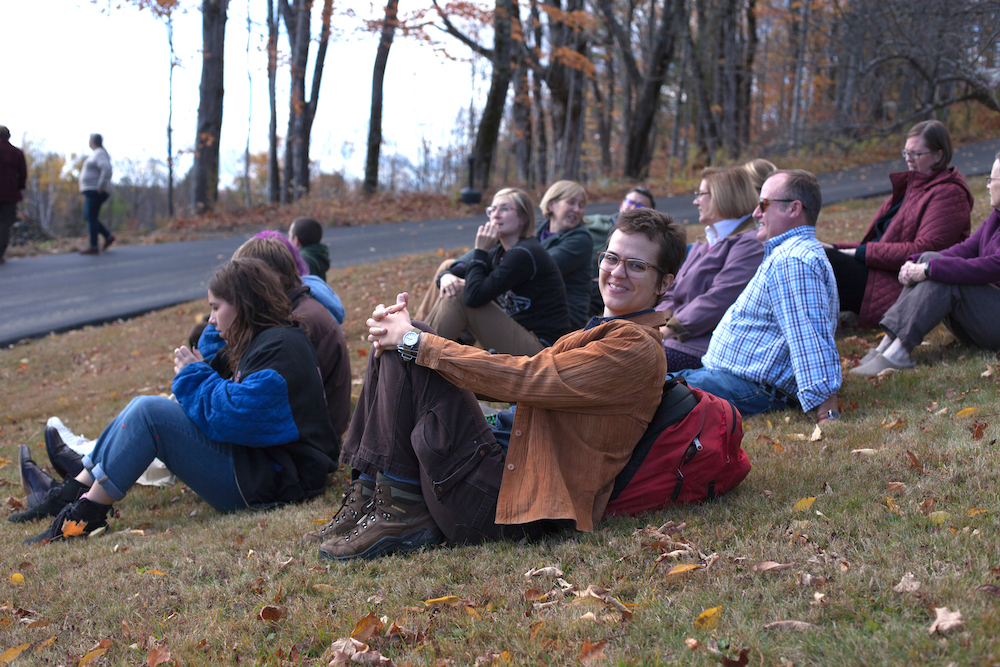 Based on the advocacy of this group, in December the board of trustees unanimously approved a severance policy for staff that was considered generous by almost any measure. The group has also been actively finding ways to support staff in terms of placement in other jobs after the Marlboro campus closes.
Based on the advocacy of this group, in December the board of trustees unanimously approved a severance policy for staff that was considered generous by almost any measure. The group has also been actively finding ways to support staff in terms of placement in other jobs after the Marlboro campus closes.
“We are thrilled with the unstinting severance policy adopted by the trustees, and it was only made possible by the vigilance of this group,” says Becky. “We realize that, of all constituents, the staff is most affected by this alliance and want them to know that we are doing all we can to soften the blow.”
Perhaps the group that has attracted the most attention and interest of other constituencies, including alumni and Marlboro townspeople, is the campus working group. The group is chaired by two alumni, Sara Coffey ’10 and Dean Nicyper ’76, and includes faculty, staff, and students as well as Alumni Council member Randy George ’93, Marlboro Town Selectman Jesse Kreitzer, and trustees Dick Saudek and Phil Steckler.
In an email to members of the working group, Sara Coffey, a Vermont state representative who served on the board of trustees for several years, said “Each of us has a deep connection to the college, and we know many of us are feeling a great loss, so this is a challenging task, but a very important one. The aim of this working group is to develop a process for gathering community input and proposals for the future use of the Marlboro College campus.”
“It sounds really simple, but as you can imagine, all the different factors that are involved in what happens on campus make it very complex,” says Nikolas Katrick ’07, MSM’16, Outdoor Program director and one of the staff representatives. “We’re trying to find great proposals that can utilize this campus and also possibly mesh together with other proposals. Anybody can submit proposals, but the working group isn’t going to workshop someone’s idea and make it viable. We don’t have the capacity to do that.”
Specifically, the working group has invited proposals for ownership and use of the Marlboro campus that will provide a significant benefit to the Marlboro community and result in a payment consistent with the campus fair market value. Any proposal must also be consistent with the terms of the Marlboro Music Festival lease and any amendments. The plan is to present the most viable proposals for review and approval by the Marlboro board of trustees, or by Emerson if they are presented after the merger.
“We have heard of widespread interest from various groups who are interested in finding some way to continue to have a managed trail network and preserve the Marlboro College Ecological Reserve,” says Sara. “These will be considerations as we move forward.” Each working group member has been collecting proposals from their respective constituents, and coordinating with state officials and counterparts at Emerson as necessary.
For more information about submitting a proposal, visit marlboro.edu/CWG. Proposals will be reviewed on a rolling basis and will be held in the strictest confidence.
Alumni Association Revival
After years of absence, the Marlboro College Alumni Association was revived last fall with the full support of the college, thanks to renewed passion among Marlboro’s alumni community and a core of committed alumni who took on the hard work of grassroots organizing. Given the possible transfer of Marlboro’s faculty, students, and pedagogy to the Marlboro Institute for Liberal Arts and Interdisciplinary Studies at Emerson College, this alumni revival came not a moment too soon.
“During this crucial time for the college, we recognize the importance of coming together,” says an October statement from members of the interim council, which now includes Heather Bryce ’04, John Coakley ’02, Daniel Doolittle ’95, Randy George ’93, Cate Marvin DuPont ’93, and Jessica Taraski ’91. The group met with 27 alumni on campus for Home Days in September, and has heard from hundreds more since then through their website and social media presence.
“We consider ourselves an interdependent association,” says Daniel. “We are independent of the college, but collaborate with the administration and trustees to share the voice of their largest constituency.” Marlboro has about 5,000 alumni, and nearly 600 had opted in as members of the association as of January—more than 10 percent in four months—ranging in class year from 1959 to 2019.
The interim council plans to have open, democratic elections for council positions in 2020, and to work in concert with the college to support alumni as well as archive their rich Marlboro memories. In the meantime, the council has made great strides in forming committees and connecting with alumni, the college administration, campus community, and trustees—one member, Randy George, is on the Campus Working Group, and a November survey by the council highlighted alumni priorities.
“It’s an incredibly interesting time,” says Daniel. “At first we were just launching the foundation to engage alumni, now we are retooling to serve changing alumni needs. We have to organize toward a completely different reality.” The Alumni Association helped make the Drop Some Love on Campus campaign a success, for example, and spread the word on the open session at December’s trustee meeting, providing alumni and other constituents access to the trustees. “One of our most important purposes is to serve as some sort of memory archive, or memory vessel, of the Marlboro experience.”
“The association gives alumni a space, which has long been absent, to process the potential closure of the college or work for different possible futures,” says John Coakley ’02, another interim council member. “No matter what happens to the Marlboro name, or the campus on Potash Hill, the Alumni Association will be there to provide that home. Marlboro’s alumni will not disappear, and their memories will only become more important in the future.”
Alumni Drop Some Love
 In November and December, just when it was needed most, the Marlboro College Alumni Association announced a Drop Some Love on Campus campaign, inspiring dozens of alumni to share their well-wishes and Marlboro stories with students, faculty, and staff. Postcards, handmade note cards, and photocopied photographs appeared on campus and were distributed by student collaborator Felix Bieneman ’21 and friends. Here is a small sampling of the bounteous love and deep Marlboro history.
In November and December, just when it was needed most, the Marlboro College Alumni Association announced a Drop Some Love on Campus campaign, inspiring dozens of alumni to share their well-wishes and Marlboro stories with students, faculty, and staff. Postcards, handmade note cards, and photocopied photographs appeared on campus and were distributed by student collaborator Felix Bieneman ’21 and friends. Here is a small sampling of the bounteous love and deep Marlboro history.
A Home Days to Remember
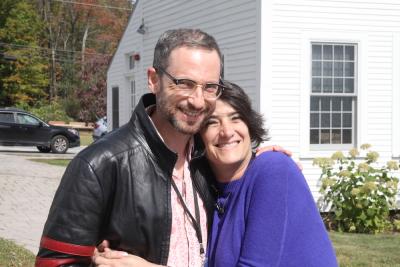 The Marlboro College campus was inundated with alumni and good vibes for Home Days 2019, September 27 through 29, an opportunity to remember, reflect, and support the college. Eager alumni came from as far away as Texas and California, and spanned over 50 graduation years, from 1968 to 2019.
The Marlboro College campus was inundated with alumni and good vibes for Home Days 2019, September 27 through 29, an opportunity to remember, reflect, and support the college. Eager alumni came from as far away as Texas and California, and spanned over 50 graduation years, from 1968 to 2019.
“It was incredible to see campus jam-packed with alumni,” says Maia Segura ’91, director of alumni engagement. The event raised over $6,000 for Marlboro, and provided a full measure of solidarity for this key constituency. “It was a ‘best of Marlboro’ day, and the love and support for our community has been overwhelming.”
Highlights included a packed house for the Alumni Dance Showcase in Whittemore Theater, featuring the work of nine alumni dancers at the height of their game, and standing room only in the dining hall for politics professor Meg Mott’s lecture on the First Amendment. A “Kevin Unplugged” session offered alumni the opportunity to hear directly from the college president about the status of merger negotiations, and to express their ideas and support. At the festive Saturday night dinner, Allison Turner MS’99 received the 2019 Roots Award recognizing her outstanding service to the Marlboro College community.
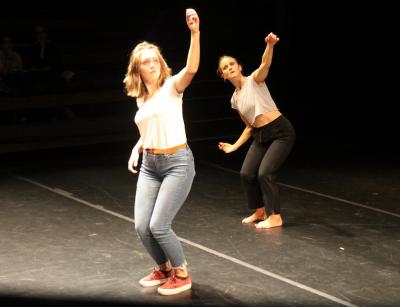 “I was very moved by the programming and energy on the Hill,” says alumna and trustee Heatherjean MacNeil ’02. “It was a stark reminder of why Marlboro is so deeply important to me, and of its ability to cultivate such an amazing community that is driven by talented and caring individuals.”
“I was very moved by the programming and energy on the Hill,” says alumna and trustee Heatherjean MacNeil ’02. “It was a stark reminder of why Marlboro is so deeply important to me, and of its ability to cultivate such an amazing community that is driven by talented and caring individuals.”
Find more photos on our flickr page. See a sampling from the Alumni Dance Showcase on Vimeo.
Alumni Get Crafty in Japan
A small group of alumni was preparing to embark on a two-week trip to Japan in May, led by Asian studies and history professor Seth Harter, before their plans were foiled by the coronavirus outbreak in Asia. Now they are setting their sights on running the trip, titled The Enigmatic Beauty of Japanese Craft, in 2021.
“Ever since the first round of Freeman Foundation– funded trips to Asia, I have been hearing from alumni wishing they could take part in such college-sponsored adventures,” says Seth. “Other colleges have been doing this for decades, but we will do it in a uniquely Marlboro way: relatively low budget, very small scale, personal encounters with brilliant, dedicated people,” says Seth.
While traveling through the heart of central Japan, participants will explore the question: how can contemporary crafts navigate between the realms of industry and fine art? They will encounter 1,300- year-old wooden temples, austere Zen rock gardens, traditional ceramics, and flamboyant textiles, exploring from the cosmopolitan hubs of Kyoto and Tokyo to the grass-thatched huts of mountain villages. The itinerary is inspired by Seth’s 2017 trip to Japan with Salvatore Annunziato ’18 (see Potash Hill Fall 2018), and his more recent sabbatical there in spring 2018.
“This trip will be an opportunity to build community, at a time when the community is feeling a bit besieged,” says Seth. “We have all been asking ourselves what parts of Marlboro will be able to endure the merger process. I think this is one thing that could flourish beyond next year, and I hope it can be reproduced by other people with other themes in other parts of the world.”
Campus Acknowledges Abenaki Homeland
In the week leading up to October 14, the first official Indigenous Peoples’ Day in Vermont, campus community members were encouraged by the Diversity and Inclusion Task Force to examine their own role in dismantling colonialism. To start with, they were asked to make a general practice of acknowledging the Sokoki (Western Abenaki) people in whose homeland Marlboro College stands.
“Land acknowledgments are often given at the beginning of public events, or in my case at the beginning of my courses,” says anthropology professor Nelli Sargsyan. “Their intention is to bring into our collective awareness the Indigenous people who have been living here and the histories of various kinds that we, as settlers, have inherited as a way of grounding.”
Land acknowledgement was one of several ways that the task force called on the Marlboro College community to observe Indigenous Peoples’ Day. Community members were also urged to do their own research to find out more about the Sokoki people and Abenaki people in general, their history, and what some of them are up to now. Further, they were encouraged to explore their own relationships to this territory, and how they came to be here.
“Our acknowledgement needs to come with a commitment, and not be something we do because it is trendy or to check a box of things progressive institutions do,” says Nelli. At Town Meeting she shared some of the recent history of this area and the impacts of colonialism, including the Vermont Eugenics Survey and systematic sterilization, and offered resources to learn more. “We each need to ask ourselves, ‘What intentions do I have to disrupt and dismantle colonialism beyond this land acknowledgement?’”
EV Charging Comes to Potash Hill
In September, Marlboro College installed an electric vehicle (EV) charging station in the admissions parking lot, a boon to students, faculty, staff, and visitors with electric or plug-in hybrid vehicles. This forward-thinking addition to campus is thanks to a Vermont State grant, as well as funds from an anonymous private donor that were dedicated to environmental stewardship and sustainability.
“Environmental sustainability is something Marlboro College has taken very seriously, from making dorms energy efficient to composting our food waste,” says chemistry professor Todd Smith, who served in the role of sustainability project manager last academic year. “The EV charging station is a very visible way of staking this claim, and encouraging the use of electric vehicles. Transportation is the single biggest contributor to greenhouse gases in Vermont, so this is one small step toward reducing that component of our ecological footprint.”
Marlboro College was one of nine locations in Vermont that received awards from a $400,000 Electric Vehicle Supply Equipment (EVSE) Grant Program last year. The grant application was an example of the college’s shared governance in action, with Todd working with Environmental Quality Committee members Amber Hunt and Matt Ollis as well as Hillary Twining, director of corporate and foundation relations. The new EV charging station will be part of a statewide network of publicly available charging stations that drivers can locate through an app.
Events
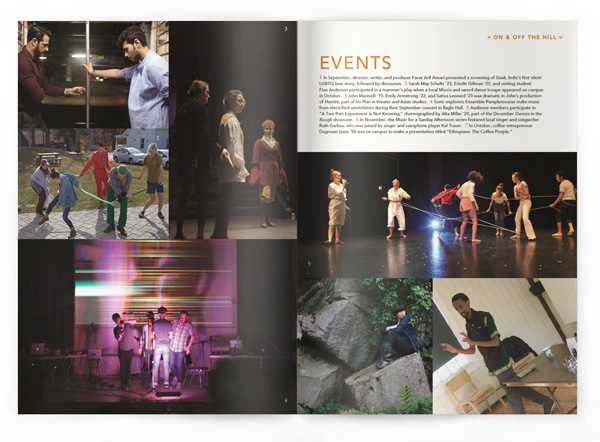
1 In September, director, writer, and producer Faraz Arif Ansari presented a screening of Sisak, India’s first silent LGBTQ love story, followed by discussion. 2 Sarah May Schultz ’23, Estelle Gillman ’22, and visiting student Finn Anderson participated in a mummer’s play when a local Morris and sword dance troupe appeared on campus in October. 3 John Marinelli ’19, Emily Armstrong ’22, and Sativa Leonard ’23 wax dramatic in John’s production of Hamlet, part of his Plan in theater and Asian studies. 4 Sonic explorers Ensemble Pamplemousse make music from electrified windchimes during their September concert in Ragle Hall. 5 Audience members participate in “A Two-Part Experiment in Not Knowing,” choreographed by Alta Millar ’20, part of the December Dances in the Rough showcase. 6 In November, the Music for a Sunday Afternoon series featured local singer and songwriter Ruth Garbus, who was joined by singer and saxophone player Kal Traver. 7 In October, coffee entrepreneur Dagmawi Iyasu ’98 was on campus to make a presentation titled “Ethiopians: The Coffee People."
Focus on Faculty
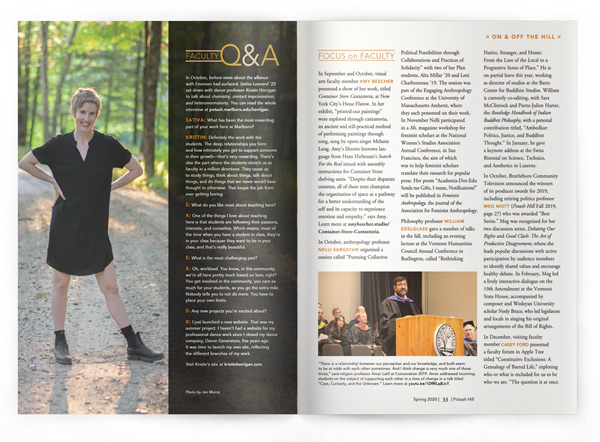
FacultyQ&A
In October, before news about the alliance with Emerson had surfaced, Sativa Leonard ’23 sat down with dance professor Kristin Horrigan to talk about chemistry, contact improvisation, and heteronormativity. You can read the whole interview at potash.marlboro.edu/horrigan.
Sativa: What has been the most rewarding part of your work here at Marlboro?
Kristin: Definitely the work with the students. The deep relationships you form and how intimately you get to support someone in their growth—that’s very rewarding. There’s also the part where the students stretch us as faculty in a million directions. They cause us to study things, think about things, talk about things, and do things that we never would have thought to otherwise. That keeps the job from ever getting boring.
S: What do you like most about teaching here?
K: One of the things I love about teaching here is that students are following their passions, interests, and curiosities. Which means, most of the time when you have a student in class, they’re in your class because they want to be in your class, and that’s really beautiful.
S: What is the most challenging part?
K: Oh, workload. You know, in this community, we’re all here pretty much based on love, right? You get involved in the community, you care so much for your students, so you go the extra mile. Nobody tells you to not do more. You have to place your own limits.
S: Any new projects you’re excited about?
K: I just launched a new website. That was my summer project. I haven’t had a website for my professional dance work since I closed my dance company, Dance Generators, five years ago. It was time to launch my own site, reflecting the different branches of my work.
Visit Kristin’s site at kristinhorrigan.com. Photo by Jen Morris
In September and October, visual arts faculty member Amy Beecher presented a show of her work, titled Container Store Cantastoria, at New York City’s Hesse Flatow. In her exhibit, “printed-out paintings” were explored through cantastoria, an ancient and still-practiced method of performing paintings through song, sung by opera singer Melanie Long. Amy’s libretto borrows language from Hans Hofmann’s Search For the Real mixed with assembly instructions for Container Store shelving units. “Despite their disparate contexts, all of these texts champion the organization of space as a pathway for a better understanding of the self and its capacity to experience emotion and empathy,” says Amy. Learn more at amybeecher.studio/Container-Store-Cantastoria.
In October, anthropology professor Nelli Sargsyan organized a session called “Pursuing Collective Political Possibilities through Collaborations and Practices of Solidarity” with two of her Plan students, Alta Millar ’20 and Leni Charbonneau ’19. The session was part of the Engaging Anthropology Conference at the University of Massachusetts Amherst, where they each presented on their work. In November Nelli participated in a Ms. magazine workshop for feminist scholars at the National Women’s Studies Association Annual Conference, in San Francisco, the aim of which was to help feminist scholars translate their research for popular press. Her poem “Academia-Dot-Edu Sends me Gifts, I mean, Notifications!” will be published in Feminist Anthropology, the journal of the Association for Feminist Anthropology.
Philosophy professor William Edelglass gave a number of talks in the fall, including an evening lecture at the Vermont Humanities Council Annual Conference in Burlington, called “Rethinking Native, Stranger, and Home: From the Lure of the Local to a Progressive Sense of Place.” He is on partial leave this year, working as director of studies at the Barre Center for Buddhist Studies. William is currently co-editing, with Sara McClintock and Pierre-Julien Harter, the Routledge Handbook of Indian Buddhist Philosophy, with a personal contribution titled, “Ambedkar: Politics, Justice, and Buddhist Thought.” In January, he gave a keynote address at the Swiss Biennial on Science, Technics, and Aesthetics in Luzerne.
In October, Brattleboro Community Television announced the winners of its producer awards for 2019, including retiring politics professor Meg Mott (Potash Hill Fall 2019) who was awarded “Best Series.” Meg was recognized for her two discussion series, Debating Our Rights and Good Clash: The Art of Productive Disagreement, where she leads popular discussions with active participation by audience members to identify shared values and encourage healthy debate. In February, Meg led a lively interactive dialogue on the 19th Amendment at the Vermont State House, accompanied by composer and Wesleyan University scholar Neely Bruce, who led legislators and locals in singing his original arrangements of the Bill of Rights.
In December, visiting faculty member Casey Ford presented a faculty forum in Apple Tree titled “Constitutive Exclusions: A Genealogy of Barred Life,” exploring who or what is excluded for us to be who we are. “The question is at once biological, affective, cultural, and political,” says Casey. “Running through each domain is a philosophical concern: to be something involves an essential relation to otherness which is not simply co-present but exclusionary.” Casey’s research project examines the specific role that “exclusion” has played in the way we have, in the West, conceived of the founding and sustaining of political community.
Spanish language and literature professor Rosario de Swanson was invited to participate in the Brattleboro Literary Festival in October, where she appeared on a panel discussion about literature and race with award-winning writers Michael Datcher and Jess Row, moderated by philosophy professor William Edelglass. She also served as a visiting professor at Bennington College for the fall, teaching a course titled Literature as Resistance: The Works of Rosario Castellanos. Given her record of publications on Latin American literature, Rosario was invited to do book reviews for Hispania, the official journal of the American Association of Teachers of Spanish and Portuguese, the first of which was due to come out in December.
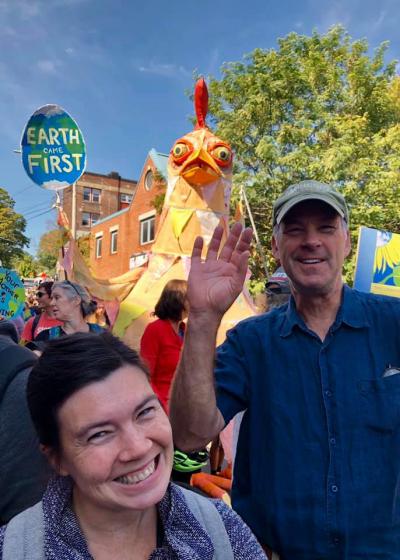 In January, literature and writing professor Rituparna Mitra presented papers in two panels, titled “The Other South Asia” and “Representational Challenges in Postcolonial Urban Studies,” at the Modern Language Association’s annual meeting in Seattle. In March, she presented a paper and co-organized a panel titled “Fictions of the Neoliberal City” at the American Comparative Literature Association’s Annual Meeting in Chicago, and also presented on the panel “Environmental Trauma and Postcolonial Writing” at the Northeast Modern Language Association’s Annual Convention in Boston. Rituparna’s essay “Precarious Duniyas: Post-Human Subjectivity and Alterglobal Politics in The Ministry of Utmost Happiness” will be published in a Postcolonial Studies special issue on “Alterglobal Politics: Postcolonial Theory in the Era of the Anthropocene and the Nonhuman.”
In January, literature and writing professor Rituparna Mitra presented papers in two panels, titled “The Other South Asia” and “Representational Challenges in Postcolonial Urban Studies,” at the Modern Language Association’s annual meeting in Seattle. In March, she presented a paper and co-organized a panel titled “Fictions of the Neoliberal City” at the American Comparative Literature Association’s Annual Meeting in Chicago, and also presented on the panel “Environmental Trauma and Postcolonial Writing” at the Northeast Modern Language Association’s Annual Convention in Boston. Rituparna’s essay “Precarious Duniyas: Post-Human Subjectivity and Alterglobal Politics in The Ministry of Utmost Happiness” will be published in a Postcolonial Studies special issue on “Alterglobal Politics: Postcolonial Theory in the Era of the Anthropocene and the Nonhuman.”
In addition to his new book, Mni Wiconi, photography professor John Willis also published an updated and expanded edition of his 2010 book Views from the Reservation (George F. Thompson Publishing) in September, based on his more than 25 years of visiting Pine Ridge Reservation. Along with his insightful and accomplished images, John has enlisted other voices to offer a more complete story, from powerful poems by Lakota elders and high school students to a story of growing up on the reservation by Emil Her Many Horses, a curator at the National Museum of the American Indian.
Theater professor Brenda Foley collaborated this past year on The Audacity: Women Speak, a play produced by Sleeping Weazel theater company. The play, which highlights real stories of women’s experiences with gender-biased treatment and sexual harassment, systemic misogyny and sexism, and assault and rape, was named by the Boston Globe as one of the ten best of 2019. Also, Routledge Publishing has selected Brenda’s book A Legacy of Violence: Women, Mental Illness, and Performance to be one of their open access texts.
Keep an eye peeled for Sisters Rising (nee Arming Sisters, Potash Hill Spring 2015), the film by visiting professor of film and video studies Brad Heck ’04 and partner Willow O’Feral ’07, making this year’s festival circuit. The film, which documents a grassroots movement to end sexual violence against indigenous women and shares the stories of survivors fighting for positive change, was invited to premiere at Big Sky Film Festival in Missoula, Montana, in February. It was also slated for a California premiere at California’s American Indian & Indigenous Film Festival, and there will be more coming. Learn more at SistersRisingMovie.com.
![]()
Also of Note
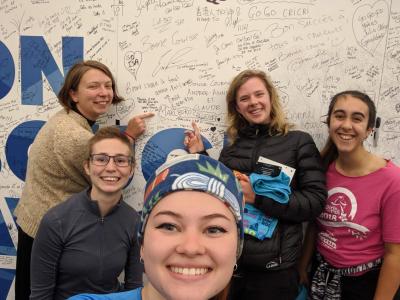 Congratulations go to five students (right) who participated in Je Cours Québec in October, a series of five major running events in the heart of picturesque Quebec City and the surrounding area. Anna Morrissey ’20 and Gina Trevethan ’22 both ran in the 5k event, while Sage Kampitsis ’20, Jenny Stofer ’20, and Claire O’Pray ’20 all participated in the 10k run. The students representing Marlboro College joined 8,400 other runners who followed the picture-postcard course alongside trees in their fall colors and some of Quebec City’s most iconic attractions.
Congratulations go to five students (right) who participated in Je Cours Québec in October, a series of five major running events in the heart of picturesque Quebec City and the surrounding area. Anna Morrissey ’20 and Gina Trevethan ’22 both ran in the 5k event, while Sage Kampitsis ’20, Jenny Stofer ’20, and Claire O’Pray ’20 all participated in the 10k run. The students representing Marlboro College joined 8,400 other runners who followed the picture-postcard course alongside trees in their fall colors and some of Quebec City’s most iconic attractions.
Two Marlboro seniors presented on their Plan research in December at 118 Elliot, in Brattleboro, hosted by the Windham World Affairs Council. Leni Charbonneau’s talk, titled “Japan and the Ainu: A Spectacle of Sustainability,” focused on the Japanese government’s recent policies regarding the indigenous Ainus, carried out under the rubric of sustainable development. Adam Weinberg presented on “Compassion for the Inconsiderate: Local Politics, Global Values,” in which he explained how resentment and vindictiveness, not disagreement, must be dealt with in order to stop cycles of retribution, using Marlboro College’s Community Court as a case study,
In December, first-year student Darien Young Man Who Is Afraid of His Horses presented a workshop titled Lakota Ways of Knowing with her mother, Davidica Little Spotted Horse, an activist and cultural advisor on Pine Ridge Reservation. The workshop supported the theme of this year’s First Year Seminars, which studied several different approaches to “ways of knowing.” “Focus has been on how knowledge is created through community, as well as what knowledge has been buried and needs to be excavated,” said Catherine O’Callahan, assistant dean of academic advising and support, who helped organize the workshop. “This was a rare opportunity to learn about a profound culture and its history.”
In September, seniors Chris Tripp and Nick Creel gave a presentation to the community about their summer internships under the National Science Foundation’s Research Experience for Undergraduates program. Chris (pictured right) described his research on “linear independence of algebraic curvature tensors in the higher-signature setting,” a project at California State University at San Bernardino, and how it ties in with his Plan in mathematics. Nick, who is completing a Plan in computer science, writing, and classics, discussed his work at the University of Rochester, conducting research in the emerging field of computer audition—designing systems that can analyze and understand sounds.
Following a lapse of a couple years, the Committee on Staff accepted nominations in November for three Distinguished Service Awards, which recognize staff for their commitment to the community and to the Marlboro College mission. The winners, announced in January, were Margaret Hunt, Tanner Jones, and K.P. Peterson, who were each awarded a $250 prize. Margaret, the longtime faculty administrative assistant, was nominated based on her ability to make things happen on short notice, from providing food for faculty gatherings to shopping for gifts for children at the college holiday party. “Even when things may be frustrating, she always has a smile on her face,” her nomination said. “Who cannot help but love her?” Tanner, the director of residence life, was recognized for working tirelessly to make sure students are safe and taken care of, and for treating everyone with respect. His nomination said, “He literally does everything imaginable for this college. I truly believe this place would not be functioning without him.” Last but not least, longtime master electrician K.P. was nominated because, “Not only does she basically run this place, but she is an absolute kickass, badass person. K.P. is part of the heart and soul of Marlboro, and literally keeps the lights on here.”
Frybread Friends 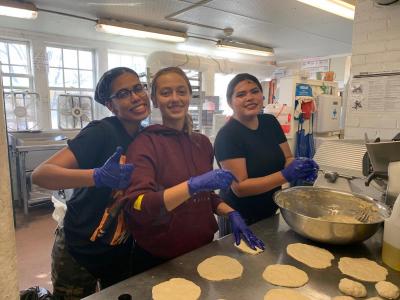 To honor Indigenous Peoples’ Day in October, students Karla Julia Ramos ’20 and Nicktae Marroquin-Haslett ’20 learn to make frybread from scratch using the family recipe of Lakota student Darien Young Man Who Is Afraid of His Horses ’22.
To honor Indigenous Peoples’ Day in October, students Karla Julia Ramos ’20 and Nicktae Marroquin-Haslett ’20 learn to make frybread from scratch using the family recipe of Lakota student Darien Young Man Who Is Afraid of His Horses ’22.
Preparing for Winter Pranit Chand ’23 and Malaya Wright ’23 prepare to spread compost on the community garden, before planting a winter cover crop, during Work Day in October.
Brightening Up Menefese Kudumu-Clavell ’20 and Angie Pham ’23 explore the possibilities of tie-dyed t-shirts on a gloomy September afternoon, one of several daytime activities designed by the student life team.